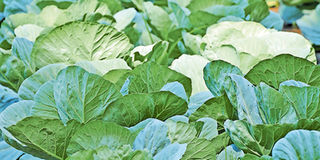Agronomist's notebook: Farming with Sh50,000; a guide for beginners

Vegetables in a farm. Farming is a lucrative business, but it needs very good planning, especially for beginners. FILE PHOTO | NMG
What you need to know:
- Farming is a lucrative business, but it needs very good planning, especially for beginners. One needs to consider the activities to be done against the risks that are likely to occur.
- Second, do a soil test in line with the water test to determine the kind of crops to grow and the nutrients available in the soil.
- In Nairobi, vegetables like sukuma wiki (collard greens), spinach, cabbages and indigenous ones like black nightshade and amaranths have high demand.
- You can include a few beds of coriander since it’s among the commonly consumed spices. Coriander should be sowed every week to ensure continuous production and supply.
Being an agronomist makes me meet very many people – well, not physically but on mail and on phone.
Last week, I opened my inbox to find this interesting dilemma from Edwin, a young farmer.
“What crop project can I do with Sh50,000 in an area around Nairobi? My parents have given me half-an-acre and it is near a river, so water is not a problem. I want to grow the money since I am a fresh graduate. Please advise from the planning stage to selling." This is the answer I offered Edwin:
Farming is a lucrative business, but it needs very good planning, especially for beginners. One needs to consider the activities to be done against the risks that are likely to occur.
To begin with, it is advisable to have a business plan and a budget indicating the investment against production costs. The plan should also show the expected yields from the crop. Planning aids in minimising the chances of failing.
In your case, it’s important to test the water to ensure its safety and suitability to growing crops.
Second, do a soil test in line with the water test to determine the kind of crops to grow and the nutrients available in the soil.
Satisfied with the results, do market survey to determine the crop that has a high demand, especially among the fast-maturing vegetables. Schools, restaurants or hotels and mama mbogas can offer you a good market.
In Nairobi, vegetables like sukuma wiki (collard greens), spinach, cabbages and indigenous ones like black nightshade and amaranths have high demand.

Thereafter, do a farm layout to mark the extent of the land and subdivide the half-acre into smaller portions. The portions will later be planted with different crops at various stages to ensure continuous production.
READY MARKET
Consider growing crops that take less than four months to mature. In case of sukuma wiki, spinach, and cabbages, seeds are first sowed in the nurseries and later transplanted.
You can plant on quarter-acre spinach and collards, the other portion divided into two plant cabbages and the other part indigenous vegetables such as black nightshade and amaranth.
You can include a few beds of coriander since it’s among the commonly consumed spices. Coriander should be sowed every week to ensure continuous production and supply.
One bed of about 20 meters would require 250 grammes of coriander seeds, which under good management can yield 90-100kg going for 60-80 per kilo. Spinach and collards green cost Sh15-Sh20 per kilo.
Later, you should consider growing high-value crops such as lettuce that takes about 45-60 days to mature, depending on the variety.

However, you can only grow such a crop if you have a ready market. Also, consider growing a border crop on the edges like maize to mark the boundaries and act as windbreaker.
If you follow your budget (see my sample right), you can minimise the cost of production especially by managing labour effectively.
Regarding pest and disease control, do frequent scouting and have preventive measures to reduce the cost of production.
Prevention is cheaper than controlling pests and diseases. The total cost of production for spinach and collard greens for a quarter acre is approximately Sh30,000, while an eighth of an acre of cabbage would cost around Sh15,000, depending on the location.
This means by the second crop season, you should be able to recover the investment cost, earn some income and, from there, grow your money.




